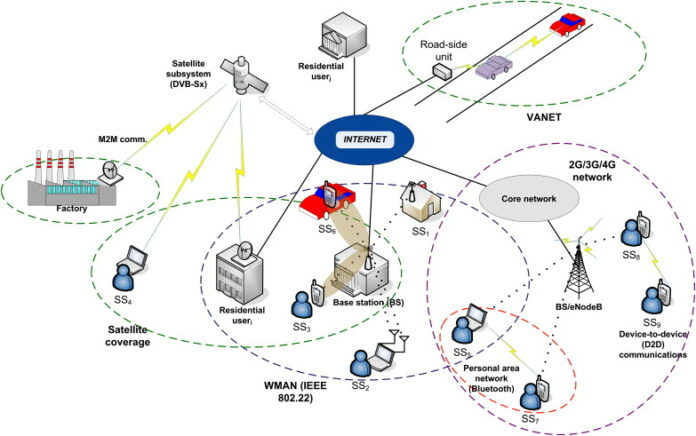IP (Internet Protocol) : Multimedia Over IP and Networking Issues
Multimedia Over IP and Networking Issues : The Internet Protocol (IP) is the principal communications protocol in the Internet protocol. Suite for relaying datagrams across network boundaries.
Its routing function enables internetworking, and essentially establishes the Internet.
Multimedia over IP : Multimedia Over IP and Networking Issues
MoIP an expression used to describe. The transport of various types of media as a payload of an IP datagram.
Typical media examples include voice, messaging and video.
Multimedia Conferencing : Multimedia Over IP and Networking Issues
Multimedia conferencing is to interact. With people across the world.
It uses certain tools like cameras. Computers and internet.
Adobe Connect is one of the tool to broadcast. The events interactively to the web.
Polycom video conferencing system. Supports meetings with peers all over the world.
The interactive conferencing includes certain gadgets. Gadgets like audio speakers, LCD projectors.
Adobe Connect need to configure. To access the multimedia.
Polycom is one of the video. Video conferencing tools.
Multimedia Conferencing Process : Multimedia Over IP and Networking Issues
Make sure that the conferencing software. Installed at both the client computers.
Make sure both of the clients connected. To the server using the internet.
Make sure all the input and output devices such as microphone. Speakers, monitors well connected.
Start the conferencing. From the conferencing software.
Multicast : Multimedia Over IP and Networking Issues
IP multicast is a method of sending Internet Protocol (IP). Datagrams to a group of interested receivers in a single transmission.
It often employed for streaming media applications on the Internet and private networks.
The method is the IP-specific version of the general concept of multicast networking.
RTP/RTCP
The RTP Control Protocol (RTCP) is a sister protocol. The Real-time Transport Protocol (RTP).
RTCP provides out-of-band statistics. Control information for an RTP session.
It partners with RTP. RTP in the delivery. Packaging of multimedia data, but does not transport any media data itself.
The primary function of RTCP is to provide feedback on the quality of service (QoS). In media distribution by periodically sending statistics information to participants in a streaming multimedia session.
RSVP
RSVP is the network control protocol that allows data receiver to request a special. End-to-end quality of service for its data flows.
Real-time applications use RSVP to reserve necessary resources at routers along. The transmission paths so that the requested bandwidth can be available when the transmission actually takes place.
RSVP a main component of the future Integrated Services Internet which can provide both best-effort and real-time service.
RTP
The Real-time Transport Protocol (RTP) is a network protocol for delivering audio and video over IP networks.
RTP used extensively in communication and entertainment systems that involve streaming media. Such as telephony, video teleconference applications, television services and web-based push-to-talk features.
RTP Work Process
RTP designed for end-to-end, real-time, transfer of streaming media.
The protocol provides facilities for jitter compensation. Detection of out of sequence arrival in data, which are common during transmissions on an IP network.
RTP allows data transfer to multiple destinations through IP multicast.
RTP regarded as the primary standard for audio/video transport in IP networks. It used with an associated profile and payload format.
Packetization
A network packet a formatted unit of data carried by a packet-switched network.
Computer communications links that do not support packets, such as traditional point-to-point telecommunications links. Simply transmit data as a bit stream.
The process of breaking down the data in smaller packets for easy transmission known as packetization.
Streaming
Streaming media multimedia that constantly received by. Its presented to an end-user while delivered by a provider.
The verb “to stream” refers to the process of delivering media in this manner. The term refers to the delivery method of the medium. Rather than the medium itself, and is an alternative to downloading.
Error Resilience
Error Resilience decides how the decoder behaves if some value in the input is against the specification. Whether it assumes it is a minor encoder mistake and “extends”. The standard to give a meaning to that input or whether it assumes the input corrupted. It should apply error concealment. i.e. assuming this and surrounding data have no relation with what the video really. Should look like and thus will try to reconstruct something. Easonable-looking e.g. from the previous frame.
This is not a speed related option (while error concealment is very slow that is not relevant. If it used when it shouldn’t be or the other way round the result will look very horrible).
Quality of Service (QoS)
Quality of Service (QoS) is a feature of routers and switches which prioritizes. Traffic so that more important traffic can pass first.
The result is a performance improvement for critical network traffic.
QoS equipment is useful with VoIP phones or in LANs with high volumes of local traffic.
Importance of Quality of Service (QoS)
Quality of service is particularly important for the transport of traffic with special requirements.
In particular, much technology has developed to allow computer networks. To become as useful as telephone networks for audio conversations, as well as supporting. New applications with even stricter service demands.
Measurement of Quality of Service (QoS)
In packet-switched networks, quality of service affected by various factors. Which can divided into “human” and “technical” factors.
Human factors include: stability of service, availability of service, delays, user information.
Technical factors include: reliability, scalability, effectiveness, maintainability, grade of service, etc.
CLICK HERE To Visit Our Website





